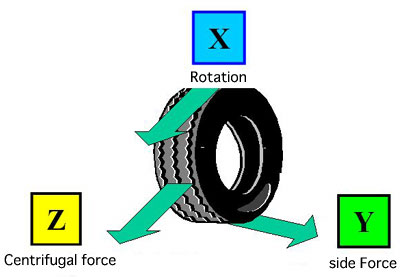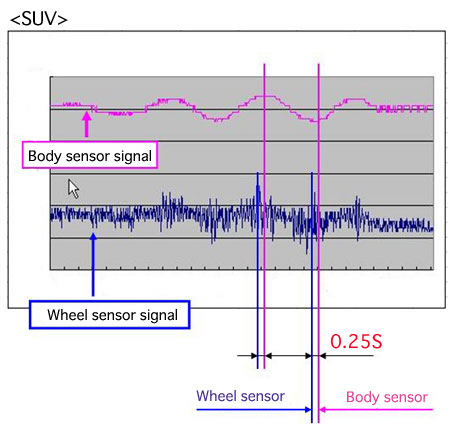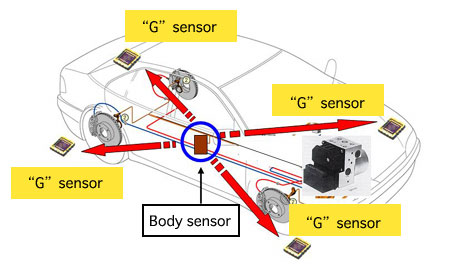News Release
Intelligent Tire Pressure Monitoring System Detects Sideslips Faster Another Advance in Vehicle Safety Technology
2005.October.28
- Tire relation
- Technical relation
Tokyo-The Yokohama Rubber Co., Ltd., announces its Intelligent Tire Pressure Monitoring System (Intelligent TPMS), which not only gauges the air pressure of tires, but also accurately identifies road conditions and tire motion across the road surface. Combined with sideslip prevention systems*, being installed on more and more vehicles, Intelligent TPMS can detect vehicle sideslips 0.2 seconds faster than existing systems - a difference of 11 meters of travel at a running speed of 100 kilometers per hour. Another advantage of the new system is the integration of tire pressure monitoring and sideslip prevention into a single system.
A sideslip prevention system controls engine power and braking at each wheel as soon as a control computer detects a sideslip, in order to maintain vehicle stability. Traditionally, various sensors installed on the vehicle's body send information to the control computer. But Yokohama found that this involves a time lag between the actual slipping of a tire and when the sensor detects it. Yokohama then developed its Intelligent Tire Pressure Monitoring System (Intelligent TPMS), making it possible to detect sideslips quicker with sensors installed directly in the tire wheels.
The key technology in the Intelligent TPMS is an acceleration sensor module, called a "G" sensor. These are positioned inside the tires, where the operating environment is more severe than in the body, and, despite their light weight (about 0.3 grams), are able to withstand vehicle speeds of up to 300 kilometers per hour - acceleration of 1,000 G's. They are, in addition, more sensitive than those in existing sideslip prevention systems when it comes to assessing vehicle motion, tire performance and conditions of the road, such as whether it is wet or dry, and can thus detect sideslips quicker and more accurately.
The number of vehicles equipped with sideslip prevention systems has been increasing at an average of about 20% annually over the past several years. Data compiled by vehicle manufacturers and others have shown such systems to be highly effective in preventing accidents. All Mercedes-Benz models are fitted with them as standard equipment. The Big Three, too, has decided to make them standard, beginning with some 2005 models, primarily large SUVs. Overall, the percentage of total vehicles equipped with sideslip-prevention is not yet high: over 35% in Europe, but just 10% or so in the United States and Japan. The market is, however, expected to grow substantially.
Yokohama released its HiTES domestically in 2003, a tire air pressure monitoring system for trucks and buses, and in 2004, its AIR Watch for passenger cars - successfully commercializing air pressure monitoring systems ahead of other companies in Japan. Yokohama will continue its development of Intelligent TPMS, which not only monitors tire pressure, but controls the vehicle through the use of "G" sensors.
*Sideslip prevention systems are called by different names by different vehicle manufacturers, including ESP (Electronic Stability Program) and ESC (Electronic Stability Control).
Left: Installed Center: "G" sensor Right: IC processor

Features of Intelligent Tire Pressure Monitoring System
3D Vibration Signal Sensor Built into Tires-a World's First
"G" sensors in the Intelligent Tire Pressure Monitoring System (Intelligent TPMS) are unique in their use of built-in 3D vibration signal sensors, in addition to built-in Air pressure and temperature sensors. The 3D vibration signal sensors detect rotation, centrifugal force and side force. As a result, tire motion, including rotation rate and direction of the steering tires, can be precisely ascertained. Data on, for example, vibration and slippage between the tire and the road is also integrated. The tire monitoring system fitted with 3D vibration signal sensors built into the tires is the first of its kind in the world.

Sensors on the Body versus Sensors in the Tires
The Intelligent Tire Pressure Monitoring System (Intelligent TPMS) can detect vehicle motion 0.15-0.2 seconds faster than sensors mounted on the body.

Structure of Intelligent TPMS using "G" sensors



